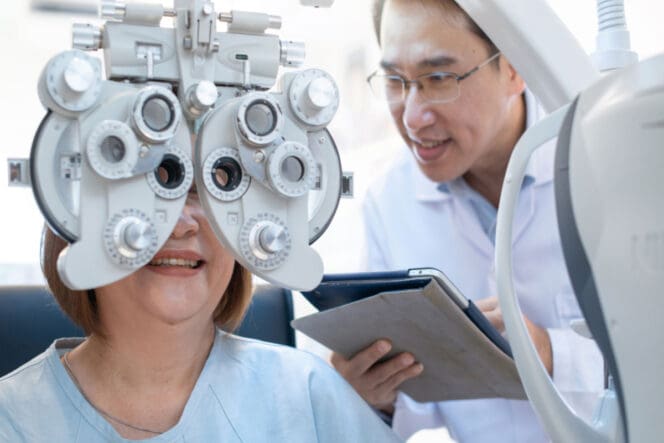The Relevance of Regular Exams with an Eye Doctor Optometrist
The Relevance of Regular Exams with an Eye Doctor Optometrist
Blog Article
Exploring the most up to date Technical Developments in Optometry and What They Mean for Eye Doctors
In the ever-evolving area of optometry, current technical improvements are improving exactly how practitioners approach eye treatment. From the accuracy of Optical Comprehensibility Tomography to the nuanced insights used by AI-driven analysis devices, these developments are setting brand-new criteria in person analysis and treatment. Teleoptometry is positioned to redefine accessibility, making sure that know-how goes beyond geographical limitations. As these innovations permeate the practice, optometrists are confronted with the difficulty of welcoming these tools to improve client end results. The concern stays: exactly how will these technical shifts redefine the roles and obligations within the profession?
Advancements in Diagnostic Devices
Progressing the area of optometry, developments in analysis devices have actually changed the method eye care professionals evaluate and identify ocular conditions and aesthetic problems. The previous decade has actually observed significant technological advancements, allowing more precise and extensive examinations.
Another secret development is the intro of advanced corneal topography systems, which map the surface area curvature of the cornea with accuracy. These devices are particularly helpful for fitting contact lenses and identifying corneal conditions. Electronic retinal imaging has changed typical ophthalmoscopy, providing thorough, scenic views of the retina that assist in comprehensive aesthetic examinations.
The growth of wavefront aberrometry has likewise been critical, allowing the analysis of refractive mistakes with unrivaled precision (Opticore Optometry). This innovation assists in personalizing restorative lenses and improving surgical end results for refractive surgical treatments. Collectively, these diagnostic improvements equip eye doctors to provide premium patient care, making certain very early intervention and customized treatment methods, ultimately boosting visual health end results
AI in Person Management
Structure on the structure of advanced diagnostic devices, the consolidation of man-made knowledge (AI) in client monitoring stands for a transformative jump for optometry. AI systems are significantly used to boost performance, precision, and personalization in patient care.
Moreover, AI-driven systems facilitate streamlined individual communications and administrative processes. Automated organizing, virtual assessments, and customized follow-up plans not just boost individual fulfillment but additionally maximize time management for practitioners. These systems can triage individuals based on the necessity of their problems, guaranteeing that those in vital need receive prompt focus.
Additionally, AI enhances decision-making by giving optometrists with evidence-based recommendations and treatment pathways. By integrating data from digital health and wellness documents, AI devices provide understandings that inform clinical decisions, minimizing the threat of mistakes and enhancing individual results. As AI remains to advance, its duty in patient monitoring will likely increase, reshaping the landscape of optometric treatment.
Advancements in Retinal Imaging
In the world of optometry, retinal imaging has observed remarkable technical developments that are boosting diagnostic abilities and client treatment. Innovations such as Optical Coherence Tomography (OCT) and fundus photography have reinvented exactly how optometrists imagine and evaluate the retina.
Enhanced imaging techniques like OCT angiography are additional refining analysis accuracy. Eye Doctor Optometrist. Such developments assist in the recognition of min retinal modifications that could represent disease progression.
Additionally, developments in expert system are enhancing retinal imaging by allowing automatic evaluation of big datasets. These systems help eye doctors in determining patterns a measure of Recommended Site pathology, thereby improving analysis accuracy and efficiency. Collectively, these advancements are changing retinal imaging right into a cornerstone of modern eye care, enhancing results and broadening restorative opportunities.
Teleoptometry's Expanding Function
Teleoptometry is increasingly coming to be a vital element of eye treatment, driven by improvements in data and analysis tools. As optometry welcomes digital change, teleoptometry assists in remote examinations, enabling optometrists to prolong their services beyond traditional boundaries. This is particularly helpful in country and underserved areas where access to specialized eye treatment is usually minimal. By leveraging high-resolution video clip conferencing and advanced retinal imaging, optometrists can perform thorough eye examinations from afar, making sure timely diagnosis and therapy.
The combination of synthetic knowledge (AI) additional enhances teleoptometry, making it possible for the analysis of aesthetic data and aiding in the discovery of ocular problems such as glaucoma and diabetic retinopathy. AI-powered formulas can rapidly analyze complicated imaging data, giving optometrists with valuable understandings that boost medical decision-making.
Moreover, teleoptometry sustains continuity of care via seamless assimilation with digital health and wellness records (EHRs), allowing eye doctors to keep thorough person histories. This ensures that individuals receive regular and tailored care even when seeking advice from various specialists.
Despite these benefits, challenges remain, including guaranteeing information protection and managing client expectations. Nonetheless, teleoptometry stands for a substantial stride towards more easily accessible, reliable, and patient-centered eye treatment. As innovation develops, its function is poised to broaden even more.

Future Fads in Eye Treatment
A myriad of cutting-edge fads is readied to improve the future of eye treatment, driven by technological advancements and the developing requirements of clients. One considerable pattern is the assimilation of fabricated knowledge (AI) in diagnostics, which promises to enhance the precision and effectiveness of eye assessments. AI formulas can evaluate vast amounts of data from retinal photos, possibly finding conditions like diabetic person retinopathy and glaucoma earlier than traditional techniques.
Furthermore, tailored medicine is acquiring traction in optometry, with genetic testing educating personalized treatment strategies. This method aims to maximize individual outcomes by tailoring interventions to private genetic profiles. Wearable innovation, such as smart contact lenses, is additionally imminent, using real-time monitoring of intraocular pressure or glucose degrees, therefore offering continuous understandings into systemic and ocular health.
The fostering of increased fact (AR) and digital fact (VIRTUAL REALITY) in training and patient education is one more arising fad. These modern technologies use immersive experiences that can improve understanding and abilities both for eye doctors and people. helpful site As these trends advance, eye doctors should remain abreast of technical developments to give cutting-edge care, making sure improved patient end results and contentment in the dynamic landscape of eye treatment.
Final Thought

Collectively, these analysis advancements empower eye doctors to supply premium patient care, making sure read the full info here early treatment and tailored therapy approaches, eventually improving visual health and wellness outcomes.

As these innovations continue to progress, optometrists need to adapt and incorporate them right into technique, eventually optimizing process effectiveness and raising the standard of eye care delivered to patients.
Report this page